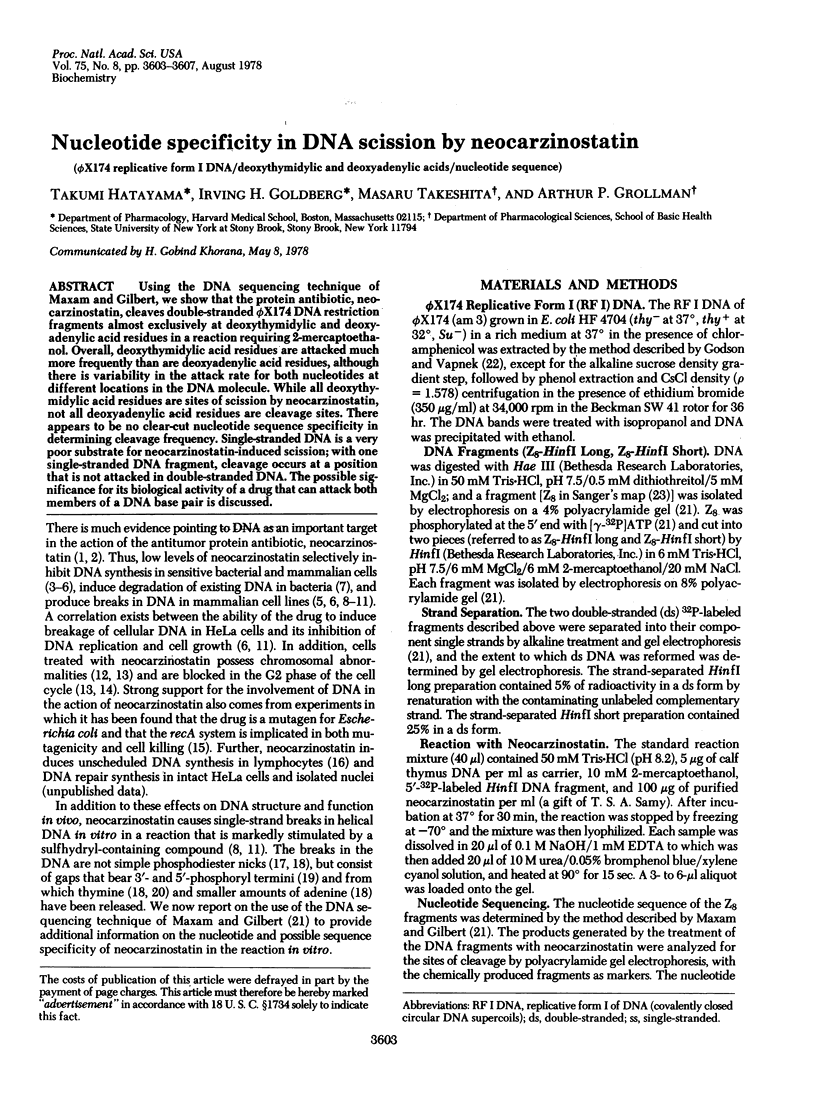Abstract
Using the DNA sequencing technique of Maxam and Gilbert, we show that the protein antibiotic neocarzinostatin, cleaves double-stranded phiX174 DNA restriction fragments almost exclusively at deoxythymidylic and deoxyadenylic acid residues in a reaction requiring 2-mercaptoethanol. Overall, deoxythymidylic acid residues are attacked much more frequently than are deoxyadenylic acid residues, although there is variability in the attack rate for both nucleotides at different locations in the DNA molecule. While all deoxythymidylic acid residues are sites of scission by neocarzinostatin, not all deoxyadenylic acid residues are cleavage sites. There appears to be no clear-cut nucleotide sequence specificity in determining cleavage frequency. Single-stranded DNA is a very poor substrate for neocarzinostatin-induced scission; with one single-stranded DNA fragment, cleavage occurs at a position that is not attacked in double-stranded DNA. The possible significance for its biological activity of a drug that can attack both members of a DNA base pair is discussed.
Full text
PDF




Images in this article
Selected References
These references are in PubMed. This may not be the complete list of references from this article.
- Beerman T. A., Goldberg I. H. DNA strand scission by the antitumor protein neocarzinostatin. Biochem Biophys Res Commun. 1974 Aug 19;59(4):1254–1261. doi: 10.1016/0006-291x(74)90449-5. [DOI] [PubMed] [Google Scholar]
- Beerman T. A., Goldberg I. H. The relationship between DNA strand-scission and DNA synthesis inhibition in HeLa cells treated with neocarzinostatin. Biochim Biophys Acta. 1977 Mar 18;475(2):281–293. doi: 10.1016/0005-2787(77)90019-3. [DOI] [PubMed] [Google Scholar]
- Beerman T. A., Poon R., Goldberg I. H. Single-strand nicking of DNA in vitro by neocarzinostatin and its possible relationship to the mechanism of drug action. Biochim Biophys Acta. 1977 Mar 18;475(2):294–306. doi: 10.1016/0005-2787(77)90020-x. [DOI] [PubMed] [Google Scholar]
- Blakesley R. W., Wells R. D. 'Single-stranded' DNA from phiX174 and M13 is cleaved by certain restriction endonucleases. Nature. 1975 Oct 2;257(5525):421–422. doi: 10.1038/257421a0. [DOI] [PubMed] [Google Scholar]
- Ebina T., Otsuki K., Seto M., Ishida N. Specific G2 block in HeLa-S3 cells by neocarzinostatin. Eur J Cancer. 1975 Mar;11(3):155–158. doi: 10.1016/0014-2964(75)90110-3. [DOI] [PubMed] [Google Scholar]
- Freifelder D. Rate of production of single-strand breaks in DNA by x-irradiation in situ. J Mol Biol. 1968 Jul 28;35(2):303–309. doi: 10.1016/s0022-2836(68)80026-9. [DOI] [PubMed] [Google Scholar]
- Godson G. N., Vapnek D. A simple method of preparing large amounts of phiX174 RF 1 supercoiled DNA. Biochim Biophys Acta. 1973 Apr 11;299(4):516–520. doi: 10.1016/0005-2787(73)90223-2. [DOI] [PubMed] [Google Scholar]
- ISHIDA N., MIYAZAKI K., KUMAGAI K., RIKIMARU M. NEOCARZINOSTATIN, AN ANTITUMOR ANTIBIOTIC OF HIGH MOLECULAR WEIGHT. ISOLATION, PHYSIOCHEMICAL PROPERTIES AND BIOLOGICAL ACTIVITIES. J Antibiot (Tokyo) 1965 Mar;18:68–76. [PubMed] [Google Scholar]
- Kappen L. S., Goldberg I. H. Effect of neocarzinostatin-induced strand scission on the template activity of DNA for DNA polymerase I. Biochemistry. 1977 Feb 8;16(3):479–485. doi: 10.1021/bi00622a022. [DOI] [PubMed] [Google Scholar]
- Kappen L. S., Goldberg I. H. Gaps in DNA induced by neocarzinostatin bear 3'- and 5'-phosphoryl termini. Biochemistry. 1978 Feb 21;17(4):729–734. doi: 10.1021/bi00597a027. [DOI] [PubMed] [Google Scholar]
- Maxam A. M., Gilbert W. A new method for sequencing DNA. Proc Natl Acad Sci U S A. 1977 Feb;74(2):560–564. doi: 10.1073/pnas.74.2.560. [DOI] [PMC free article] [PubMed] [Google Scholar]
- Meienhofer J., Maeda H., Glaser C. B., Czombos J., Kuromizu K. Primary structure of neocarzinostatin, an antitumor protein. Science. 1972 Nov 24;178(4063):875–876. doi: 10.1126/science.178.4063.875. [DOI] [PubMed] [Google Scholar]
- Ohtsuki K., Ishida N. Mechanism of DNA degradation induced by neocarzinostatin in Bacillus subtilis. J Antibiot (Tokyo) 1975 Mar;28(3):229–236. doi: 10.7164/antibiotics.28.229. [DOI] [PubMed] [Google Scholar]
- Ohtsuki K., Ishida N. Neocarzinostatin-induced breakdown of deoxyribonucleic acid in HeLa-S3 cells. J Antibiot (Tokyo) 1975 Feb;28(2):143–148. doi: 10.7164/antibiotics.28.143. [DOI] [PubMed] [Google Scholar]
- Ono Y., Watanabe Y., Ishida N. Mode of action of neocarzinostatin: inhibition of DNA synthesis and degradation of DNA in Sarcina lutea. Biochim Biophys Acta. 1966 Apr 18;119(1):46–58. doi: 10.1016/0005-2787(66)90036-0. [DOI] [PubMed] [Google Scholar]
- Poon R., Beerman T. A., Goldberg I. H. Characterization of DNA strand breakage in vitro by the antitumor protein neocarzinostatin. Biochemistry. 1977 Feb 8;16(3):486–493. doi: 10.1021/bi00622a023. [DOI] [PubMed] [Google Scholar]
- Rao A. P., Rao P. N. The cause of G2-arrest in Chinese hamster ovary cells treated with anticancer drugs. J Natl Cancer Inst. 1976 Nov;57(5):1139–1143. doi: 10.1093/jnci/57.5.1139. [DOI] [PubMed] [Google Scholar]
- Sanger F., Air G. M., Barrell B. G., Brown N. L., Coulson A. R., Fiddes C. A., Hutchison C. A., Slocombe P. M., Smith M. Nucleotide sequence of bacteriophage phi X174 DNA. Nature. 1977 Feb 24;265(5596):687–695. doi: 10.1038/265687a0. [DOI] [PubMed] [Google Scholar]
- Sawada H., Tatsumi K., Sasada M., Shirakawa S., Nakamura T. Effect of neocarzinostatin on DNA synthesis in L1210 cells. Cancer Res. 1974 Dec;34(12):3341–3346. [PubMed] [Google Scholar]
- Tatsumi K., Nakamura T., Wakisaka G. Damage of mammalian cell DNA in vivo and in vitro induced by neocarzinostatin. Gan. 1974 Oct;65(5):459–461. [PubMed] [Google Scholar]
- Tatsumi K., Nishioka H. Effect of DNA Repair systems on antibacterial and mutagenic activity of an antitumor protein, neocarzinostatin. Mutat Res. 1977 Apr;48(2):195–203. doi: 10.1016/0027-5107(77)90161-0. [DOI] [PubMed] [Google Scholar]
- Tatsumi K., Sakane T., Sawada H., Shirakawa S., Nakamura T. Unscheduled DNA synthesis in human lymphocytes treated with neocarzinostatin. Gan. 1975 Aug;66(4):441–444. [PubMed] [Google Scholar]







